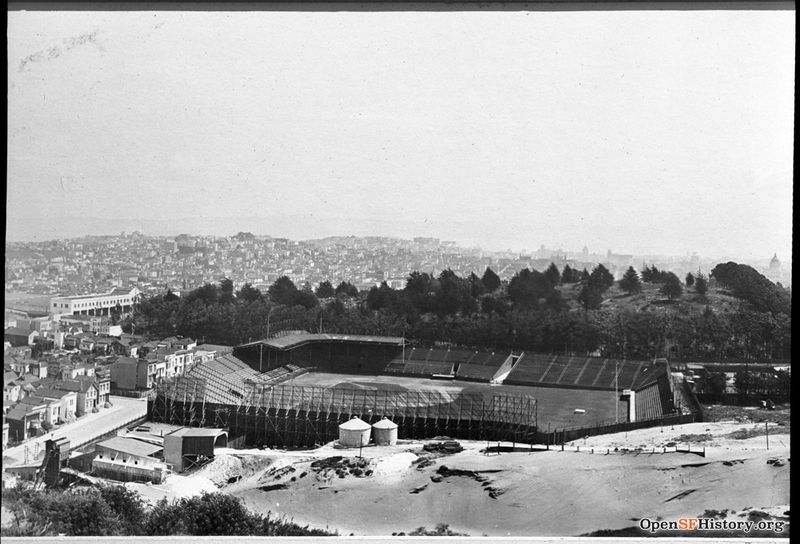Ewing Field Epilogue
Historical Essay
by Angus MacFarlane
Concluding the saga of early 20th century baseball in San Francisco and the much-mythologized story of fog-bound Ewing Field.
1915-1938: EPILOGUE
After a brief respite following the last baseball game of 1914 at Ewing Field, 4,000 spectators converged at the repurposed facility on February 14, 1915 to see . . . a baseball game. Harry Wolverton led a contingent of Pacific Coast League players against a squad of major leaguers in a benefit game for a severely injured ball player. On that same day the final soccer match was played at what had become the city’s main soccer venue: Recreation Park. Several other baseball games filled out the month of February at the old ball yard before soccer claimed the turf.
On April 4 gale-force winds pummeled the city. At Ewing Field, according to the Chronicle, “enough wind blew to sail a fleet of ships”. At Recreation Park the wind flung roofing material off the grandstand and onto the field during a Seals-Oaks game.
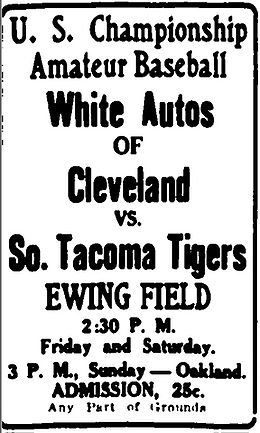
After months of soccer, baseball returned to Ewing Field on October 22 and 23. This was not just any baseball game—it was the U.S. Amateur Baseball Championship between the White Autos of Cleveland and the South Tacoma Tigers. The Chronicle wryly observed, “All that was lacking to make it a world series was attendance.”
The archdiocese released Cal Ewing from his twenty-year lease on November 6, 1915. A week later fans by the thousands packed the field that would continue to bear his name for the next 23 years to see the return of the Big Game to San Francisco after an absence of 12 years. Truthfully, this was not the real Big Game. In 1906 a nationwide campaign against the dangers of “American” football resulted in almost all of the high schools and colleges switching to rugby, including Cal and Stanford. Following the 1914 Big Game, Cal returned to American football while Stanford continued to play rugby. Thus, the two rivals were unable battle each other. Consequently, the 1915 substitute big game pitted Stanford against Santa Clara University in a rugby match. On November 13, 12,000 alternative-football fanatics witnessed Stanford shut out Santa Clara 30-0.With spring’s arrival, soccer resumed its dominance over Ewing Field, but baseball—in this case high school baseball—would not be denied its moment on the field for the brief spring high school season.
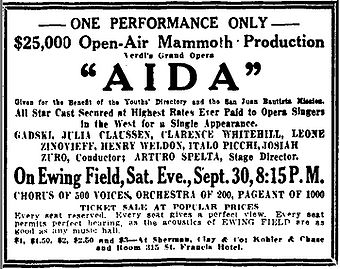
Then came the Aida fiasco. On September 30, 1916 Ewing Field was to be the scene of the grand outdoor performance of Verdi’s Grand Opera set in Egypt. Weeks of preparation and rehearsals with a 500-voice choir, 200 musicians, 100 dancers and 1,000 supernumeraries on a stage larger than the infield (100 x 125 feet) were all for naught. Twenty thousand tickets had been sold but the performance was rained out. Lloyd’s of London covered the $25,000 loss and 10,000 lucky ticket holders saw a scaled-down Aida indoors at the Exposition (Civic) Auditorium on October 3.
Immune to the vagaries of weather, high school rugby took center stage till Stanford and Santa Clara played their second other big game. In warm November sunshine, over 13,000 saw Santa Clara avenge last year’s loss to Stanford.
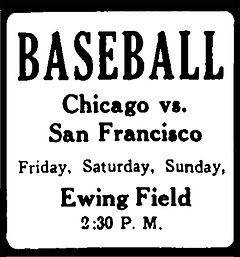
The unimaginable happened in 1917: the Seals returned to Ewing Field. Henry Berry had succeeded where Cal Ewing had failed in obtaining the property along 15th Street, thus allowing for the expansion of Recreation Park. Demolition of the old park began in December 1916, but work was not completed in time for a three-game pre-season series against the Chicago Cubs. Inundated by sunshine, the Seals staged a triumphant return to their old home grounds on March 16 with a 3-2 victory before a huge crowd. The Seals took two of three from the Windy City nine before bidding once again and forever more adieu to Ewing Field, yielding the turf to the ruggers and soccer players.
The Stanford ruggers won the 1917 big rugby game at Ewing Field in front of 10,000. Following the 1918 big game that drew a crowd “too small to count,” Stanford came to its senses and returned to American football.
In 1920, the city’s amateur athletic fields were Saint Ignatius Stadium on the opposite side of Lone Mountain from Ewing; The Park Stadium at the Polo Field in Golden Gate Park; Ocean Shore Grounds at 12th and Mission; Central Park at 8th and Market; and Ewing Field. With its large seating capacity, Ewing was the main venue for field sports (soccer, rugby, football and lacrosse) for the city’s high schools, colleges and athletic clubs.
View east from Lone Mountain, c. 1920.
Photo: courtesy OpenSFHistory.org wnp37.10045
San Francisco high schools resumed American football in 1921, becoming consistent and dependable crowd pleasers. After the six-month baseball season ended, football was the only game in town. Without radio or TV, one had to be there or read about it in the papers the next day. Many chose to be there. The big attraction was long-time rivals Polytechnic and Lowell in their annual “High School Big Game”.
On October 16, 1921 the football powers of Stanford University and the Olympic Club played before 5,000 spectators at Ewing. The Poly-Lowell High School Big Game a month later drew 10,000. In 1922 neither Poly nor Lowell were championship contenders, yet 7,000 football fanatics sat through a downpour as the two squads wallowed in Ewing Field’s mud to a scoreless tie on November 11.
In 1923, primarily due to the phenomenal popularity of high school football and its ability to attract paying spectators to the facility, St. Mary’s College and Santa Clara University leased Ewing Field and invested $15,000 to expand its capacity to 26,000. The first football cleats to chew up the new turf belonged to the Poly and Commerce teams on October 3, 1923. Four thousand early birds saw the Poly Parrots soar to a 33-0 triumph. A month later the High School Big Game between Poly and Lowell drew 13,000 witnesses to another Parrot victory.
On November 10, The Lords of Ewing Manor (St. Mary’s and Santa Clara) played the first of what would become an annual tradition between the two schools: “The Little Big Game.” Santa Clara squeaked by 10-9 before 12,000 collegiate football fans. The next day more than 15,000 high school gridiron enthusiasts packed Ewing Field as Poly defeated Lick Wilmerding to capture the city football championship.
Poly and Lowell didn’t face each other in 1924, so, hungry for knock-‘em, rock-‘em, sock-‘em football, 23,000 collegiate fans packed Ewing Field for the Little Big Game on an ideal Thanksgiving Day. The following week 12,000 high school fans attended the championship game between Lowell and Lick Wilmerding.
The early-to-mid 20s was unquestionably Ewing Field’s heyday. A debacle as a baseball stadium, it found its niche as the city’s pigskin palace where some of the largest sporting crowds in San Francisco history congregated at the once-ridiculed field.
As far back as 1913 there was such deep dissatisfaction with the city’s only publicly owned athletic facility, Park Stadium, that the city proposed building a new one at the southeast corner of Golden Gate Park across the street from Polytechnic High School. Part of the proposed site included an unused Market Street Railway yard that had been a dumping ground for years. The rest was an old nursery and stables in Golden Gate Park that even John McLaren looked forward to being rid of. Nothing happened for years except for the annual projects in Professors Mohr’s and Connor’s classes at Polytechnic to survey the site for a new stadium.
In 1921 the Poly student body led by its President James Rolph III, son of San Francisco mayor Sunny Jim Rolph, finally got the city moving on a new stadium. A few more years passed until work began in 1924. Kezar Stadium was finished in May of 1925. This city-owned field that could accommodate 22,000 fans was a boon to athletes, especially the high schools, but Ewing Field was still an important resource for the city’s athletes.
The 1925 high school schedule of football games was evenly distributed between Ewing and Kezar. The November 27 High School Big Game at Kezar attracted 15,000 rooters, the same as the St. Mary’s/Santa Clara University Little Big Game at Ewing.
On December 26, 1925, Ewing Field received national attention for something other than weather- related ridicule: the first East-West Shrine College All Star Game. The Chronicle gushed, “Never before have there been so many stars of national reputation in one competition.” The West won 7-0 before 20,000 on a touchdown by Cal’s Brick Muller. On June 5, 1926 a fire destroyed the original baseball grandstand along the north and east sides of the field. The 21-alarm blaze also consumed dozens of neighboring homes, causing over $300,000 in damage. Wind-blown embers carried by a 40-mile per hour wind set fires more than a mile away.
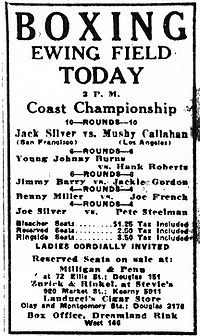
Ewing Field was insured and on July 7 its gates were opened for a scheduled boxing match that drew 7,000 aficionados of the pugilistic arts. Reporting on the match, the Chronicle observed “There is little to make you remember that Ewing Field was the scene of a disastrous fire several weeks back. New fences have been raised where there was nothing but a burned section and temporary grandstand and bleacher seating have been provided.” However, the gutted grandstands weren’t rebuilt, reducing Ewing Field’s capacity from 26,000 to 12,000.
In addition to team sports, Ewing Field was the occasional setting for boxing matches. Originally these bouts were a small part of a larger athletic spectacle, but in 1925 boxing promoters spent $15,000 to adapt the field for a world’s welterweight boxing championship match. On May 16, eleven days after Kezar Stadium opened, 10,000 paid up to $6 for a ringside seat to witness the five-card match. After four preliminary bouts, the main event lasted 90 seconds as the champ, Mickey Walker, KO’ed Lefty Cooper.Most of the 1926 high school football games were played at Ewing. One exception, of course, was the High School Big Game that drew 15,000 to Kezar, nearly double the 8,000 who went to Ewing to watch Lick Wilmerding and Galileo vie for the city championship.
The 1926 exodus to Kezar also included the Little Big Game, played on November 27 before 15,000. Even though the second East-West Shrine game was held at Kezar on January 1, 1927, Ewing Field still had a lot to offer. Mervin S. Cowen, an astute sports promoter, reasoned that if the public was willing to pay good money to watch amateur high school and college football, they should be willing to pay great money to watch professional football. The fledgling National Football League was attracting paying spectators back east, so why not have professional football on the west coast?
Accordingly, on November 7, 1926 a four-team professional football league was formed. The Pacific Football league had teams in San Francisco, Oakland, Los Angeles and Hollywood. Ewing Field was to be the home of the San Francisco Tigers. On November 14, 1926, 3,000 football fans were present for the first professional football game in San Francisco history. The Tigers fell to the Oakland Oaks 3-0.
Although the league flopped a month later, Cowen saw another money making opportunity in having an all-star team of west coast professionals battle the barnstorming eastern professionals who were currently in Southern California. On December 18, about 4,000 gridiron gawkers saw Ernie Nevers, Stanford’s former great All American fullback, and his Duluth Eskimos beat the California All Stars of the Pacific Football League 19-0.
On January 10, 1927, Brick Muller, the hero of the first East-West game played at Ewing Field just over a year earlier, was once again the star of the professional clash at Ewing Field. Cheered on by 8,000, the local pros shut out the NFLers 19-0. Another pro football game was played before a packed house of 12,000 on January 24. In the last pro game of the season, Red Grange, “The Galloping Ghost”, and his New York Yankees played a team of all-star college graduate players. With the winner taking 70% of the pot, 7,000 cheered as former University of California stars Brick Muller and Tut Imlay, along with Stanford’s Ernie Nevers, bested the pros 7-6.
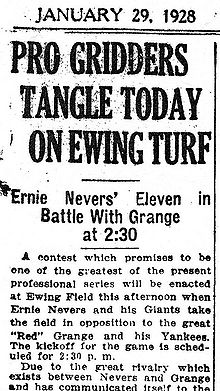
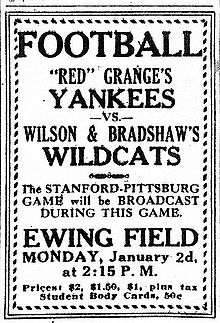
Following the conclusion of the 1927 eastern professional football season, Cowen enticed four groups of barnstorming pros to California: Ernie Nevers and his Duluth Eskimos; Red Grange and his New York Yankees; a contingent known as George Wilson’s All Stars; and Benny Friedman and his group of pros. It was Cowen’s intent to have a winter West Coast Professional Football League made up of these four teams who would play each other in San Francisco and Los Angeles over the course of six weekends in January and February. Once again Ewing Field would be the site of the San Francisco contests.
The first game on January 2, 1928 pitted Red Grange’s New York Yankee squad against George Wilson’s Wildcats. About 5,000 watched the two elevens wallow in the Ewing Field mud to a 6-0 Wildcat victory. Next week’s perfect weather brought over 7,000 who saw Ernie Nevers’ team fall 13-6 to Benny Friedman’s Bulldogs.
By the third week the novelty had worn off as just 2,000 paid to watch the unbeaten Bulldogs hand the Wildcats their first loss 12-6. Rain cancelled the following week’s game. Since the endeavor was dependent on gate receipts, it wasn’t worth the money to play in bad weather before a small crowd. The end of the professional experiment was a 13-13 tie between Nevers’ and Grange’s teams before the smallest crowd of the season.
The next time professional football players tore up Ewing Field’s turf was January 1933 when the Green Bay Packers used the field as a practice facility to prepare for a Knights of Columbus charity game at Kezar Stadium.
In the meantime, high school football was simply becoming too popular for Ewing Field as evidenced by the 30,000 who squeezed into the 22,000-seat capacity Kezar Stadium on November 24 to watch the 1927 Poly-Lowell game. Just as the other city fields of the late teens and early 20s couldn’t compete with Ewing Field, now Ewing Field couldn’t compete with Kezar.
Early in 1928, plans were announced to expand Kezar to 60,000 for the 1928 football season. Work was completed just in time for the 50,000 who saw the Poly-Lowell game on November 29, 1928. On November 2, 1930 nearly 40,000 were on hand for the High School Big Game, 15,000 more than at the Poly-Mission championship game four weeks later.
By 1931 the exodus to Kezar was complete. There were no more high school games or large crowds at the old yard; just weekend warriors playing before small turn-outs of friends and family.
On January 19, 1937 Cal Ewing died at 69 years of age. Following his sale of the Seals in 1914, he returned to baseball in 1916 as the president of the Oakland Oaks. He remained with the club till 1934 when he resigned for health reasons, ending nearly half a century of Bay Area sports leadership.
Ewing Field outlived its namesake by seventeen months.
Lone Mountain aerial, January 16, 1937, Ewing Field at left, middle.
Photo: courtesy OpenSFHistory.org wnp14.10919
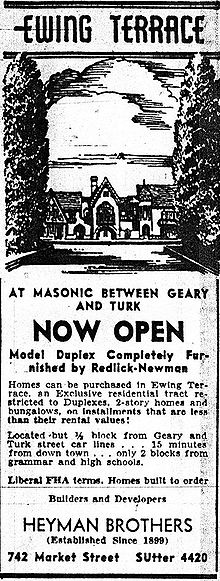
The Heyman Brothers Construction Company bought the land from the archdiocese in June 1938 for $150,000. Demolition began on Halloween 1938. On July 29, 1939 the first homes in what was called Ewing Terrace were being advertised for $7,950 and up. One of the amenities of the new homes was a glass enclosed interior patio that would allow sunshine, light and warmth directly into the homes.
Twenty years later a new stadium was under construction—Candlestick Park. Over the 54-year span of Candlestick’s life, tens of millions of fans attended baseball, football and other events at the stadium that everybody loved to hate because of the same weather conditions that people absolutely hated Ewing Field for: the wind, the cold, and the fog.
On Candlestick’s opening day at least two spectators were in attendance who had been at Ewing Field’s inaugural. And once again they didn’t pay. Examiner sports scribe Prescott Sullivan sat high above the field in the press box while Governor Edmund G. “Pat” Brown shared the field level VIP box with San Francisco Mayor George Christopher, baseball Hall of Famer Ty Cobb, and Richard Nixon.
Might Scotty and Pat have gotten together and recalled their earlier gate-crashing escapade?
Surely, during Candlestick Park’s first years there were enough old timers still around to recall the days of 1914 and compare them, for better or for worse, with the 1960s. What might they have said?

